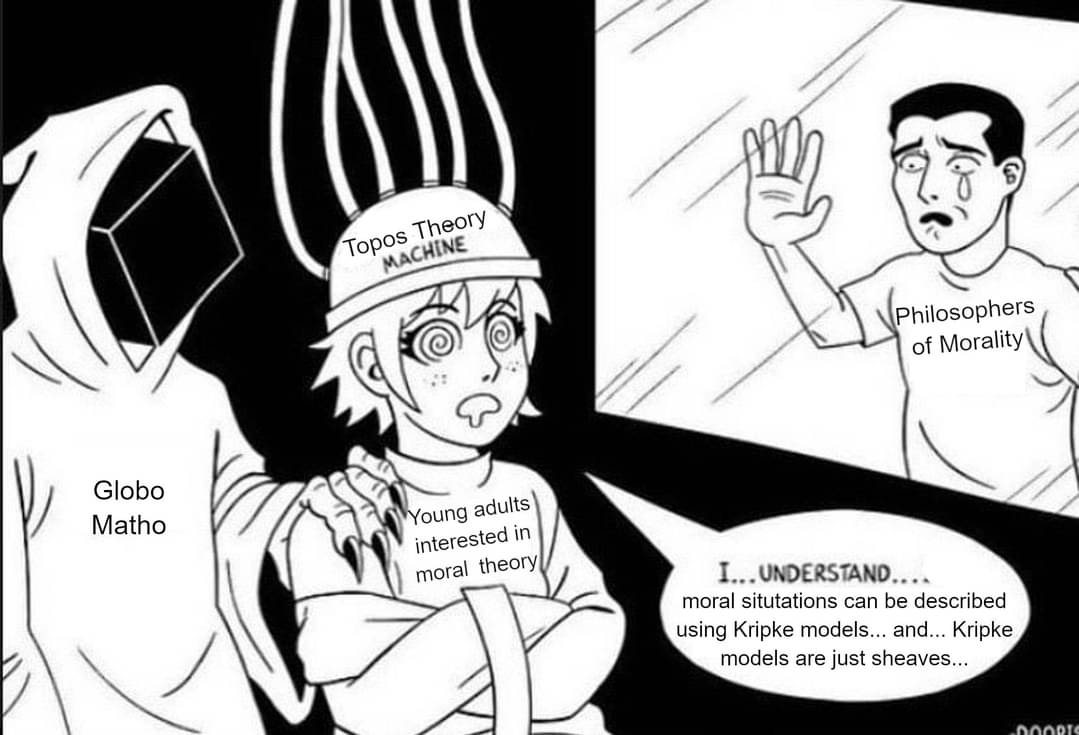I have a PhD in moral philosophy and I have no idea what's going on here.
I am really trying to follow this, but I need more coffee I think. I am happy to be educated if it can be explained a little easier or some good reference material.
I definitely don't get this comic, but I can give us a starting point on the first statement: "moral situations can be described using Kripke Models"-
Kripke Models are based on Modal Logic, which is a way of doing formal logic including definitions of "necessarily" and "possibly". The link between Modal Logic and ethics is Deontic logic, where "necessarily" is taken to mean "obligatory" and "possibly" means "permitted". Sheaves and Topos theory are pure mathematics stuff and "Globo Matho" doesn't mean anything as far as I can tell.
Be sure to let us all know if you find out what this means!
From what I gathered from the Wikipedia page of Kripke Models, they take the form of something like a graph (nodes and edges). My mediocre knowledge of higher math makes me wave my hands and say something about Category theory also working with graph-like structures and that sheaves and topoi definitely come up there, too.
What
Wow that's a very specific reach of a meme
Big Globo
Worst thing to happen to moral philosophy since Sam Harris decided to write a book about it.
Ig "moral" and "modal" looks close enough
I would like to reply to ridicule with another ridicule: Women are immune to maths.
Science Memes
Welcome to c/science_memes @ Mander.xyz!
A place for majestic STEMLORD peacocking, as well as memes about the realities of working in a lab.

Rules
- Don't throw mud. Behave like an intellectual and remember the human.
- Keep it rooted (on topic).
- No spam.
- Infographics welcome, get schooled.
This is a science community. We use the Dawkins definition of meme.
Research Committee
Other Mander Communities
Science and Research
Biology and Life Sciences
- !abiogenesis@mander.xyz
- !animal-behavior@mander.xyz
- !anthropology@mander.xyz
- !arachnology@mander.xyz
- !balconygardening@slrpnk.net
- !biodiversity@mander.xyz
- !biology@mander.xyz
- !biophysics@mander.xyz
- !botany@mander.xyz
- !ecology@mander.xyz
- !entomology@mander.xyz
- !fermentation@mander.xyz
- !herpetology@mander.xyz
- !houseplants@mander.xyz
- !medicine@mander.xyz
- !microscopy@mander.xyz
- !mycology@mander.xyz
- !nudibranchs@mander.xyz
- !nutrition@mander.xyz
- !palaeoecology@mander.xyz
- !palaeontology@mander.xyz
- !photosynthesis@mander.xyz
- !plantid@mander.xyz
- !plants@mander.xyz
- !reptiles and amphibians@mander.xyz
Physical Sciences
- !astronomy@mander.xyz
- !chemistry@mander.xyz
- !earthscience@mander.xyz
- !geography@mander.xyz
- !geospatial@mander.xyz
- !nuclear@mander.xyz
- !physics@mander.xyz
- !quantum-computing@mander.xyz
- !spectroscopy@mander.xyz
Humanities and Social Sciences
Practical and Applied Sciences
- !exercise-and sports-science@mander.xyz
- !gardening@mander.xyz
- !self sufficiency@mander.xyz
- !soilscience@slrpnk.net
- !terrariums@mander.xyz
- !timelapse@mander.xyz
